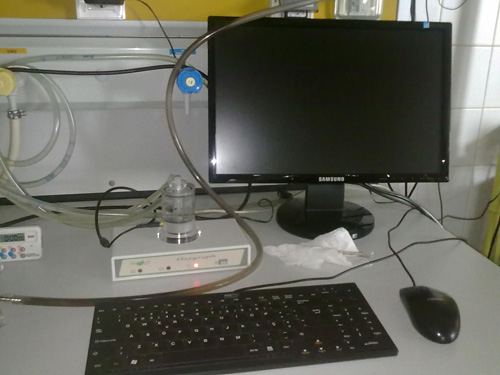Techniques
Cellular steady-state titration
A critical step to accomplish our studies is to investigate the actions
of low H2O2 levels. A group member (F. Antunes) developed an approach - cellular
steady-state titration. This method of H2O2 delivery to cells is far superior to the usual bolus addition because:
a) It mimics the continuous endogenous production of H2O2 in vivo as opposed to the bolus addition,
which disrupts cellular homeostasis;
b) It standardises the deliver of H2O2,
because H2O2 is delivered as a steady-state concentration; in the bolus addition the actual dose of H2O2 delivered per cell is unknown because it depends both on the density of the cells and on the consumption of H2O2 by the growth medium, which makes comparison of data between laboratories difficult;
c) It allows the distinction of cellular responses according to the [H2O2]
that triggers them, contrary to the bolus addition, where often the cellular responses are lumped together.

In order to obtain a H2O2 steady-state, we first need to determine the rate of H2O2 consumption by cells we are going to use. Then we add to the cells H2O2 at the concentration we want to work (e.g. 25 µM) and, at the same time, we add glucose oxidase in such quantity as to counteract the H2O2 consumption by cells. H2O2 concentrations are measured as O2, after the addition of catalase, using an Hansatech oxygen electrode.
- Antunes F., Cadenas, E. (2001) Cellular titration of apoptosis with steady-state concentrations of H2O2. Sub-micromolar levels of H2O2 induce apoptosis through Fenton chemistry independent of the cellular thiol state. Free Radic. Biol. Med., 30, 1008-1018.[abstract]
- Antunes F., Cadenas, E. (2000) Estimation of H2O2 gradients across biomembranes. FEBS Lett., 475, 121-126.[abstract] [
 ]
] - Oliveira-Marques, V., Marinho, H.S., Cyrne, L., Antunes, F. (2009) Role of hydrogen peroxide in NF-kB activation: from inducer to modulator. Antioxid. Redox Signal., 11, 2223-2243. doi:10.1089/ARS.2009.2601.
- Marinho, H.S., Cyrne, L., Cadenas, E., Antunes, F. (2013) H2O2 delivery to cells: steady-state versus bolus addition. Methods Enzymol. 526, 159-176. doi:10.1016/B978-0-12-405883-5.00010-7.
- Marinho, H.S., Cyrne, L., Cadenas E., Antunes, F. (2013) The cellular steady-state of H2O2: latency concepts and gradients. Methods Enzymol. 527, 3-19. doi:10.1016/B978-0-12-405882-8.00001-5.
- Cyrne, L., Oliveira-Marques, V., Marinho, H.S., Antunes, F. (2013) H2O2 in the induction of NF-kB-dependent selective gene expression. Methods Enzymol. 528, 173-188. doi:10.1016/B978-0-12-405881-1.00010-0.
- Covas, G., Marinho, H.S., Cyrne, L., Antunes, F. (2013) Activation of Nrf2 by H2O2: de novo synthesis versus nuclear translocation. Methods Enzymol. 528, 157-171. doi:10.1016/B978-0-12-405881-1.00009-4.
Other techniques
- Protein analysis by 2D-gel-electrophoresis and Western blotting. Enzymatic activities.
- Fluorescence microscopy.
- Flow cytometry.
- Metabolic radiolabeling of yeast (Saccharomyces cerevisiae) and mammalian cell lines for the analysis of proteins. Immunoprecipitation, SDS-PAGE, autoradiography.
- Extraction, purification, derivatization and analysis of lipids from cellular membranes. Separation of lipids (1- and 2-dimensional TLC, HPLC). Analysis of lipids by GC-MS.
- Genetic methods: mutant selection and screening in S. cerevisiae. Promoter replacement, protein-tagging. Northern blot.
- Cell culture
